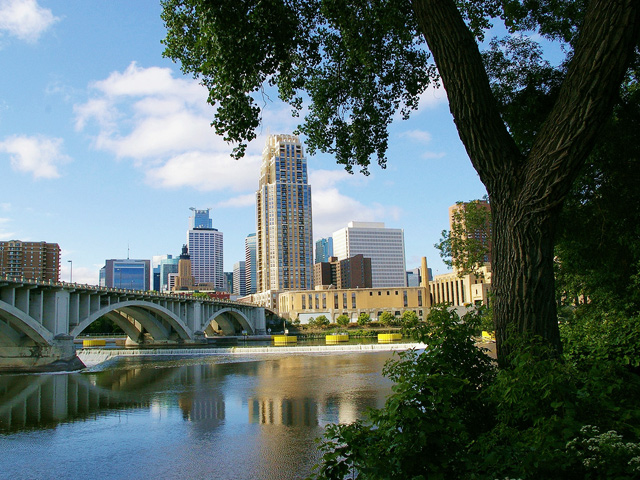
With four internationally known art museums, three Tony Award-winning theaters, and a full slate of festivals year-round, Minneapolis is one of the country’s most cultured cities. Photo © Ron Reiring, licensed Creative Commons Attribution.
The bluff-lined Mississippi River, the waterfall-rich North Shore, the arts-loving Twin Cities, and the lake-filled Boundary Waters Canoe Area Wilderness all lie on the eastern side of Minnesota, but there are superb surprises in the west, and you can’t really know Minnesota without taking a turn through the prairie.With four internationally known art museums, three Tony Award-winning theaters, and a full slate of festivals year-round, Minneapolis is one of the country’s most cultured cities, while quiet St. Paul, where the primary attractions are its historic buildings, is one of its most stately. Together the pair makes an easily navigable and satisfying urban destination.
Some people, in their rush to get “Up North,” drive through this region and never know what they’re missing: postcard-perfect towns like Marine on St. Croix and Stillwater, and gorgeous gorges in the state parks to the north. The St. Croix River is protected as a National Scenic Riverway and serves up some superb quiet-water paddling, while other rivers have wild white water.
The northeast corner has more than its fair share of Minnesota’s best and most beautiful, starting with the port city of Duluth. Minnesotans themselves named the stunning views along the North Shore of Lake Superior among 150 iconic state treasures. And, on the other side of the region, Old World culture lives on in the mining towns of the Iron Range. Tucked in the middle are Voyageurs National Park and the Boundary Waters Canoe Area Wilderness, arguably the best canoeing destination in the world.
Minnesota’s lake country, much of it covered by the 1,042-square-mile Chippewa National Forest, is the most popular family vacation destination for Minnesotans.
The waters are lined with resorts, and the towns are full of gift shops and amusement parks. The Mississippi River is born in Itasca State Park (one of many lovely state parks), and this region is also the epicenter of Minnesota’s giant sculpture habit, so oversized animals and Paul Bunyans welcome you to many small towns.
The farm fields of the Red River Valley stretch seemingly forever, broken only by scattered small towns and parks, including the wonderful Agassiz National Wildlife Refuge. Unheralded Moorhead is home to the Scandinavian-focused Historical and Cultural Society of Clay County, and nearby is Buffalo River State Park, with one of the largest and healthiest remaining prairies. The towns and parks along the Otter Trail Scenic Byway are Minnesota in microcosm.
While southwest Minnesota is mostly farm country—broken by the deep, tree-lined Minnesota River Valley—it has a surprisingly varied assortment of attractions, including the sacred (Pipestone National Monument and Jeffers Petroglyphs) and the weird (Belle Plaine’s two-story outhouse). Fans trek to Walnut Grove, home of Laura Ingalls Wilder, and a few scattered patches of prairie remain, most notably at Blue Mounds State Park.
In southeast Minnesota, steep bluffs rise as much as 500 feet over the Mississippi River, which widens to form the stunning Lake Pepin, a popular summer playground for water buffs. Glimpses of the river’s shipping heyday live on in picturesque towns like Red Wing and Winona, and farther inland, in Amish Country, pleasant villages like Lanesboro and Harmony harken back to a simpler time.
Minnesota’s glorious summers, with long, lingering evenings and temperatures in the 80s, are the most popular with tourists, but visitors shouldn’t write off winter, when locals make the most of the snow with outdoor activities and even festivals.
Spring comes in like a lion and races through like a cheetah, lasting as little as a couple of weeks—if you can even be sure just when it begins. Few visitors come at this time, but a profusion of wildflowers and the cheapest lodging of the year are bonuses for those who do. With mild, sunny, dry weather, beautiful foliage, and off-season discounts, fall is the best time to visit.
Excerpted from the Fourth Edition of Moon Minnesota.